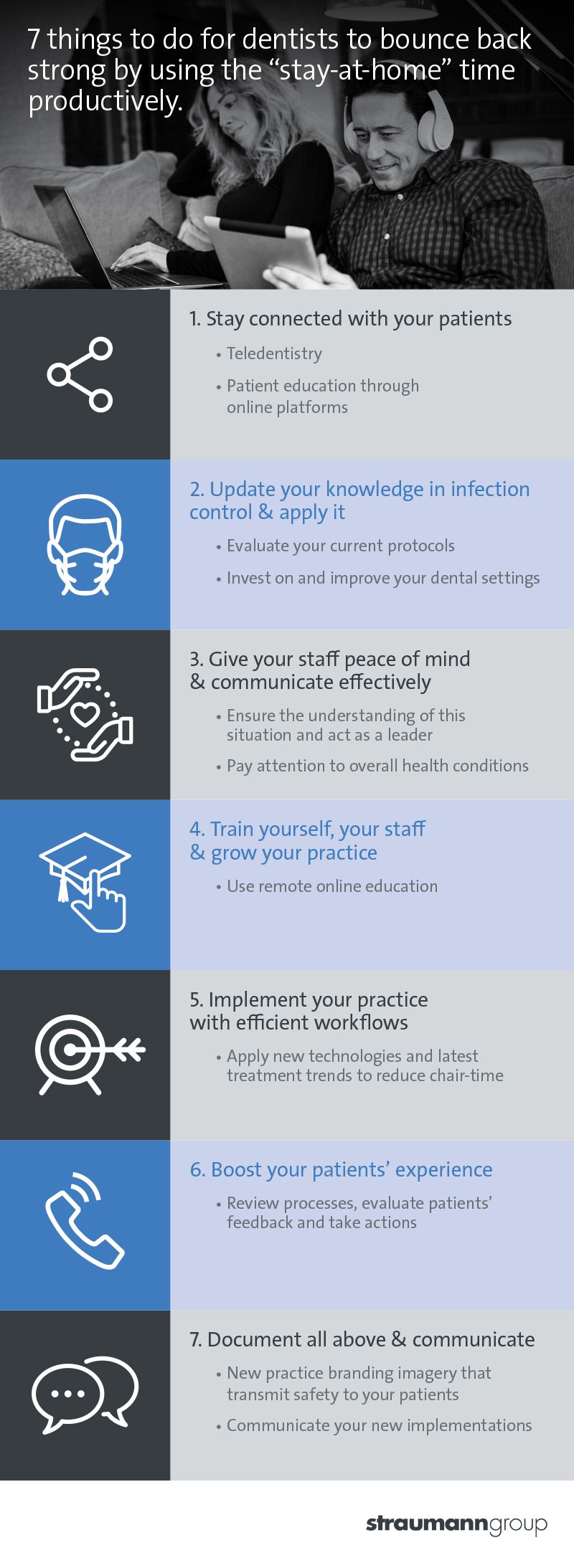The on-going COVID-19 pandemic is disrupting the daily life of millions of people around the world, and we, as dental professionals are not the exception. We are facing a challenge that we have not been prepared for: practices closed or limited to emergency cases.
No dental school nor management training program trained us to deal with a situation like this. However, there are still useful ways to invest our time while away from the dental office.
If this sounds familiar to you and you would like to be more productive as you are and make a strong bounce back to the post-lockdown; below, there are seven practical tips for you:

1. Stay connected with your patients
- Teledentistry
Teledentistry is a relatively new field that combines telecommunication technology and dental care. A recent survey showed that 78% of respondents believe they are likely to use teledentistry services within the next 5 years.
This is a solution that can help practices to efficiently and safely consult with patients and foster open communication; and as consequence increase patient engagement, streamline operations, and reduce costs of dental care. Although it is not possible for all the dental procedures, the remote delivery of dental care can allow us to provide initial consultations, follow-up treatments, preventive advice, and other non-invasive procedures.
Web healthcare applications with real-time communications are currently available in the market. When considering implementing this solution in our dental practice, it is important to select the tool(s) according to our needs and to make sure that we are operating within the Health Insurance Portability and Accountability Act (HIPAA) guidelines in order to maintain the integrity of the patients’ Protected Health Information (PHI). Some examples of available and compliant solutions are VirtualCheck & Photo Monitoring Light.
Time is gold, and the safety of our patients and staff is primordial for all in the dental community. Teledentistry plays an important role in this process. Our business is changing, and it is likely that with time more practices adopt these technologies, not only during this pandemic but in the future as well.
- Patient education through online platforms
Like everyone else, our patients are full of questions during these uncertain times and like it or not, many of them look for information online.
The Internet has changed the world over the past decades, placing global audiences at each other’s fingertips and significantly expanded the access to evidence-sharing, patient-communication and education. However, the online world is also filled with irrelevant, fake, or confusing information; therefore, we as dental professionals, must take up the role to guide here.
It is crucial that we rely on reputable and official COVID-19 sources for dental professionals in our location. We can share the most relevant information for our patients using our online platforms in snackable and didactic formats or organize live Q&A (question and answers) on Instagram, Facebook, or YouTube to have real-time interaction with them. Try to do it very often, as this will keep patients engaged and will allow them to know more about the disease and the recommended behaviors in a fun way. Other relevant topics to share during this period are the oral hygiene and preventive measures at home, curious dental facts and the differentiation between urgency/emergency and elective treatments
2. Update your knowledge on infection control & apply it
- Evaluate your current protocols
As dentists, we appear to be at high risk of contagion due to the exposure to saliva, blood, and aerosol/droplet production during most of the procedures. Thus, our role is crucial in limiting the effects of virus diffusion.
COVID-19 risk won’t disappear right after the lockdown; therefore, it is a great time to review all our protocols and contrast them with our local health authorities’ statements and official guidelines. Re-evaluate every step of the patients’ treatment journey, from the moment he/she asks for an appointment until the period where he/she comes for the maintenance visits.
- Invest on and Improve your Dental Settings
It is essential to promote frequent and thorough hand washing and invest on material and equipment for infection control. Moreover, the establishment of regular housekeeping practices, including cleaning and disinfecting of surfaces, equipment, and all elements of the dental settings is fundamental. For this, we must ensure that all cleaning chemicals are EPA (Environmental Protection Agency)- approved, as these products are expected to be effective against SARS-CoV-2.
When selecting the Personal Protective Equipment (PPE) for our staff and patients, we should consider factors such as function, fit, decontamination ability, disposal and costs. Sometimes, if PPE will have to used repeatable for a long period of time, a more expensive and durable type of PPE may be less expensive overall than disposable PPE.
High volume saliva ejectors and avoid/minimizing procedures that generate spatter or aerosol are highly recommended.
Finally, make sure that you can maintain natural air ventilation and re-arrange all spaces in your clinic following official guidelines: the reception area, waiting room, common areas and dental rooms.
3. Give your staff peace of mind & communicate effectively
- Ensure the understanding of this situation and act as a leader
Organize frequent online meetings and make sure that all your staff, including not only dentists and dental hygienists but also administrators, cleaners, or guards; understand the current situation and have the essential knowledge and skills to perform in all dental settings following all protective measures. It is recommended that especially our receptionist is ready to perform telephonic screenings of all patients before scheduling an appointment.
Today, more than ever, a strong leadership is needed. If you want to learn more, check the advices from well-known management consulting companies like McKinsey and business magazines such as HBR and Forbes on how to lead your team during this particular time.
- Pay attention to overall health conditions
Moreover, it is also important to ensure that the health status of the entire staff is optimal, including their mental health. People cope with this new situation in different ways, and we need to be ready to provide support if needed.
Recently, the WHO presented a list of mental and psychosocial considerations that can be used as a series of messages in communications for different target groups during the outbreak. You can find there, recommendations for both healthcare workers and team leaders or managers in health facilities. It’s never late to start putting them in practice!
4. Train yourself, your staff and grow your practice.
Let’s think about what we always wanted to learn or improve in the past, but we didn’t do because of the lack of time; and ask the same to our staff. We now have the opportunity to prepare ourselves, our practice, and our team for the bounce-back.
Due to this special situation, currently there are high-quality content resources available free-of charge for different fields in dentistry. Take advantage of this remote education and attend online webinars, symposiums, case studies & solution-driven learning tutorials.
It’s #TimeForEducation and some examples of content-rich and evidence-based platforms are Straumann Group CampusLive, ITI@Home, and Straumann® Smart Educational Platform; and the best part is that we can not only improve our knowledge in Dentistry but also build and implement our practice by learning insights about practice management tools as well as practice- and patient marketing.
5. Implement your practice with efficient workflows
Chair-time has become a very significant factor to take into consideration in the dental field. In the interest of safety and financial conditions, there will be an increased demand for a broad range, affordable, efficient and immediate solutions for our patients.
It’s time to explore new opportunities to increase our productivity in the most efficient and simple ways by shortening our daily treatment time with the latest technologies and trends in treatments and other new developments in our field.
Immediate protocols can clearly reduce the number of appointments, reduce costs and improve patient morbidity. Moreover, digital workflows can reduce the chair-time and therefore, the spread of the infection; as communication with the lab can be done digitally, from the planning to the manufacture of the final restoration.
If you want to start now, you can also take advantage of the Digital Central Services available like Smile in a Box. This tool provides a modular, integrated treatment planning and manufacturing service to cover all our patient’s surgical and prosthetic steps.
6. Boost your patients’ experience
Our daily work is mainly focused on the solutions we provide to our patients, and very often we do not pay that much attention to the service aspect. Now it is the perfect time to review every step of our patients’ treatment journey and put ourselves on their shoes to look for improvements. All the patient’s experience must be evaluated, taking into consideration factors such as the appointment management, parking availabilities, patient entrance, environment, waiting experience, communication of treatment/costs, and follow-up procedures.
Patients’ feedback can also be a lot of help, as this is firsthand information. If you did not perform any survey in the past, this could be a great opportunity to ask your patients for feedback and show your care for them. One tip: try to keep 4 to 5 questions and allow open answers.
Once we identify our weak points, it is time to improve our processes. Our staff will certainly be involved, and we need to ensure that all the team is aligned.
If you want to learn more about how to create a great customer experience in the dental practice, watch this video or take a look to the Straumann® Patient Pro solution!
7. Document all above & communicate
This outbreak gives us also the opportunity to update our website and online platforms. We can improve our content with new imagery and photography reflecting the changes we went through to meet all local health guidelines and recommendations. This will undoubtedly transmit confidence to our patients and will reflect our care for safety.
And don’t forget to communicate through your site the new protective measures and protocols implemented in your practice. Our patients need to be updated with this relevant information and know what to expect during the next visit; or if it is a new one, during his/her first experience with our team.
To sum-up:
As health professionals, we play a crucial role in preparing people for this new situation. It is important that we, our staff and our patients understand well what we are dealing with, and more importantly, have the right mindset.
We all hope that soon we can go back to our “normal” daily life; however, we should keep in mind that our profession is in a changing process, and this is the perfect time to adapt and prepare for a strong bounce back.
“The comeback is stronger than that setback”, and hopefully you found valuable insights in this article that will help you to master the next stage!
***This article cannot replace official statements issued by your local health authorities or government guidelines***
